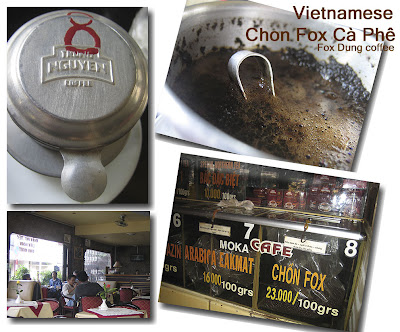Saigon - cà phê culture
Before I go into coffee, here's where we stayed at - Oscar Saigon. Cute ad on the wall of the building. Notice the Christmas greetings? It's funny how many of them didn't bother taking down the Christmas and New Year decorations. I guess they're too busy cruising around on their motorbikes or sipping coffee at the street stalls. LOL..
A coffee song just for you. Play it as you read my post :
 Coffee culture in Vietnam is alive 'n' kickin'! Coffee shops line the streets and almost everyone serves Vietnamese coffee. It would be hard for Starbucks or Spinelli's to establish themselves here with such "strong" competition.
Coffee culture in Vietnam is alive 'n' kickin'! Coffee shops line the streets and almost everyone serves Vietnamese coffee. It would be hard for Starbucks or Spinelli's to establish themselves here with such "strong" competition.One of the most expensive and sought-after coffees comes from Vietnam, especially the 'Cà Phê cut chon' or 'fox dung coffee', made from coffee beans that have been eaten and 'passed through' the civet cat (which looks like a fox). This process enhances the taste of the beans and makes them highly desirable to coffee connoisseurs worldwide. Fortunately, modern methods are employed these days so we can spare the civet cat from being force-fed with coffee beans!
We went to Trung Nguyen to have a drink and also buy their freshly ground Cà Phê cut chon. The shop was at a corner of a busy bus interchange and looked like it was frequented by locals. 23,000VND/100gm is about S$2.20. For espresso quality coffee, that is REALLY cheap!

Once you get over the thought of where the fox dung coffee comes from, you will most definitely enjoy your (tiny) cup of caramelly & chocolatey, slow-dripped coffee. It's hardly acidic, very fragrant and the after-taste is exquisite.
We each bought 2 stainless steel filter pots from An Dong Plaza for 35,000 VND (S$3.40 - a steal, really) hoping to recreate the wonderful taste of Vietnam back home. Sad to say, we failed miserably! Fortunately Mag found a website detailing the process. We'd been doing it wrong! No wonder my coffee was tasteless. This is how you make cà phê nóng (black) :

The Vietnamese filter consists of 4 essential parts
- a saucer with holes which you place on top of your cup
- a small pot in which you place your coffee and water
- a inner screen filter which you would use to cover your coffee powder
- a cover to keep the heat in
 It is important to unscrew and remove the inner screen filter.
It is important to unscrew and remove the inner screen filter.Put about 3 to 3½ teaspoons of coffee into the small pot. Shake the pot a little to level it up.
Place the top screen filter back into the pot, sandwiching the coffee.
 Screw tight, firmly but gently, and when it is tight, losen it by half a turn.
Screw tight, firmly but gently, and when it is tight, losen it by half a turn.It should hold the coffee in place and allow the water to seep evenly and slowly through the coffee powder, drawing every ounce of taste & goodness out from the 'black gold'.
 To test the correct snugness, pour some hot water into the small pot until it is about ¼ full.
To test the correct snugness, pour some hot water into the small pot until it is about ¼ full.Wait for 20 seconds... If all the water flows out in 20 secs, tighten up some more.
If you're happy with the snugness, top up the small pot with more hot water and cover it up.


Now all you have to do is wait.......

The water should drip ever so slowly through and should not be flowing.
Good things come to those who are patient, so be patient and you will be rewarded with a fragrant cup of coffee, thick with taste and bite.
This makes me wanna go make a cuppa for myself NOW! I'm gone...
:-)





2 comments:
So did you succeed? When do we get to try? Hey you have the shadow software?
The coffee is stronger and more bitter but it still lacks something that the ones served in Vietnam has... :/
You can try anytime. Might run out of powder by the time you get back to S'pore again tho! :P
Still the same software I've been using - Adobe Elements. It's got Layer Effects, Layer Styles, Filters. Guess you'll have to get it soon... :)
Post a Comment